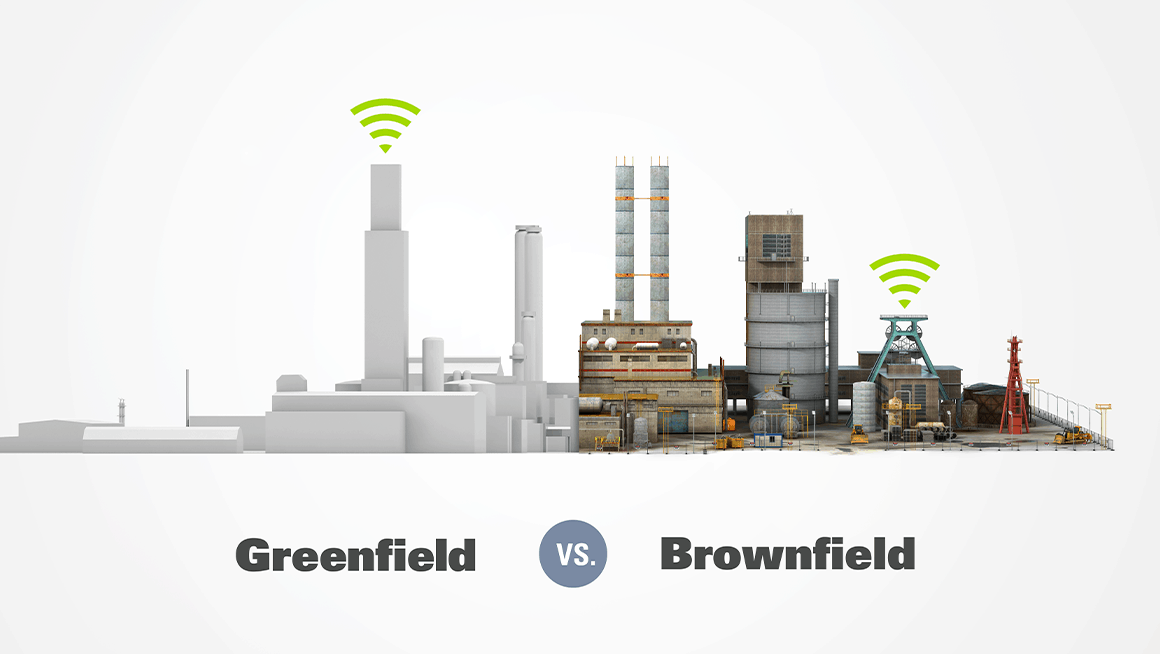
GREENFIELD
Over the long term, all new manufacturing
will likely come online that employs the latest
Without a precedent, a design can be fluid without encumbrance. The IIoT infrastructure can be included within the design of the complete facility to make sure that interoperability is established at the forefront (Dickson B). The required networking, equipment and communications needed to make the IIoT a reality will all be included as part of the master plan. However, without running a new operation to establish baselines, any new IIoT implementation may not have the historical data models to gain full benefit of its promised efficiencies.

A brownfield IIoT deployment, by contrast, requires that any new infrastructure must co-exist with the incumbent equipment and systems. This can be challenging as the decisions made to use the original systems have usually been made some time ago by a different team with an alternate agenda. In many cases the equipment may have been deployed before the connected internet was even established. Discrete operations may operate in isolation without communication outside their own domain. New IIoT systems and protocols need to be able to operate along this installed base without disruption. (Wind River)
However, despite the hurdles, a brownfield IIoT architecture can be put in place to satisfy the manufacturing requirements and offer improvements. Integrators now have the tools and ability to avoid conflicting IIoT ecosystems that are not compatible with one another. The communications between connected sensor nodes and gateways within a brownfield environment is often the largest hurdle to overcome. However, wireless protocols and communications can co-exist as a wrapper within the existing framework. Translation layers can also be employed that act as hand shaking intermediaries to mend the gap of multiple disparate protocols.
A brownfield implementation often bridges the divide between operational technologies and information technology (Dariol M.). Typically, this means that open IT standards are the best solution as opposed to continuing any closed proprietary solutions from prior installations that can be costly and constraining. An open architecture approach offers a wider selection of technology, training and support options. This includes the move to open IT standards for data storage such as SQL databases.
To overcome the communications gap between new and legacy infrastructure, gateway hardware can be introduced that connects to devices within a factory. Data aggregation is performed on the gateway from multiple sensors and potential fusion with algorithms. Gateways have several data ingestion points, either wireless or wired, to link existing equipment to access the IIoT cloud. The cloud is the data analysis destination for final processing, modeling and decision outcomes.
FOCUS
A brownfield implementation inherently makes more sense than that of a greenfield since it can be targeted at the known issues already recurring within the manufacturing facility. The existing manufacturing weaknesses and areas for improvement are well established over a long period of time. For example, prior maintenance and operational data for equipment is readily available for parsing. Processed sensor data should be able to target outlier areas of interest when compared to a historical data model for the factory.
Conversely, the high performing areas of the facility are also known and may not warrant any adaptation whatsoever. Therefore, targeting a vast array of unknown possibilities at areas that don’t have any problems makes little sense. Instead, incremental IIoT deployment can be targeted just at those critical issues that provide the largest benefit to the existing structure, without intrusion into other areas of the operation that are not required.


A greenfield IIoT has neither of these benefits. Upon launch, it will mostly be monitoring new equipment and processes that should ideally work perfectly at the onset. A historical data perspective of the operation will not be known. Predictive models will require training and will be much less efficient without this prior art. Sensing solutions may prove to be unworthy or delayed
Whether a manufacturing IIoT deployment is for an existing Brownfield installation or Greenfield, either can be deployed with confidence. While a greenfield option may employ the latest technology and have a seamless integration from the start, those pursuing a brownfield approach should not be deterred. IIoT solution providers and integrators can bridge the divide between existing legacy equipment to introduce new hardware and communicate with software along common platforms. Brownfield engagements also have the upside of the existing historical context from which to draw modelling behavior and comparisons for improvement.
WE ARE MAKING
THE UNKNOWN KNOWN
THROUGH ADVANCEMENTS IN DATA.
Results Engineering is an IIoT/Industry 4.0 systems integrator that has been working in plants for the last 30 years. Our role is to guide our clients on the path to IIoT implementations, achieving ultimate plant control.
